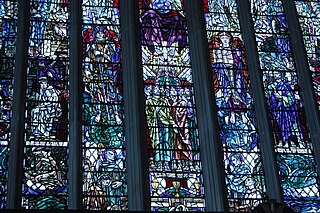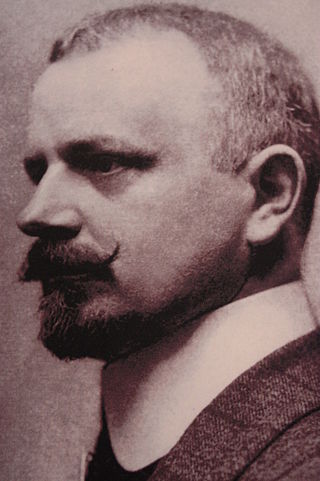
Queen's Cross Church is a former Church of Scotland parish church in Glasgow, Scotland. It is the only church designed by Charles Rennie Mackintosh to have been built; hence, it is also known as The Mackintosh Church.

Douglas Strachan is considered the most significant Scottish designer of stained glass windows in the 20th century. He is best known for his windows at the Peace Palace in The Hague, Netherlands, at Edinburgh's Scottish National War Memorial and in cathedrals and churches throughout the United Kingdom. He is also known for his paintings, murals, and illustrations.

Christopher Whitworth Whall was a British stained-glass artist who worked from the 1880s and on into the 20th century. He is widely recognised as a leader in the Arts and Crafts movement and a key figure in the modern history of stained glass.

Sarah Hall is a stained glass artist from Canada. Sarah Hall is internationally recognized for her large-scale art glass installations and solar projects. Her work can be found in churches, synagogues, schools, and other commercial and public buildings in Canada, the US, and Europe.

Veronica Mary Whall (1887–1967) was an important stained glass artist, painter, and illustrator associated with the Arts and Crafts movement. Her father, Christopher Whall, was the leader of the movement in stained glass. She was educated in the techniques of painting and stained glass making in her father's studio-workshop. She later became his studio assistant and designer for his studio in 1914. In 1922, Whall and her father co-founded a stained glass studio together, which she managed for nearly thirty years after his death in 1924.

Karl Bergemann Parsons was a British stained glass artist associated with the Arts and Crafts movement.

Wilhelmina GeddesHRUA was an Irish stained glass artist who was an important figure within the Irish Arts and Crafts movement and also the twentieth century British stained glass revival. Notable works include windows at St Bartholomew's, St Peter's Church, and the King Albert Memorial Window, St Martin's Cathedral.
Rosemary Kilbourn is a Canadian printmaker, illustrator and stained glass artist known for her work in the wood engraving.

Lawrence Stanley Lee was a British stained glass artist whose work spanned the latter half of the 20th century. He was best known for leading the project to create ten windows for the nave of the new Coventry Cathedral. His other work includes windows at Guildford and Southwark Cathedrals as well as a great number of works elsewhere in the UK, and some in Canada, Australia and New Zealand.

Margaret Isobel Chilton (1875–1963), born at Clifton, Bristol, was a British stained glass artist and instructor.
Herbert Hendrie was an English stained glass artist. He is known for his strong simple designs with scintillating jewel-like effects. Among his best-known works are the fifteen windows for Kippen church and the tall stained glass windows for Liverpool Cathedral.

Peter Haworth was a British-born Canadian painter. He was known for his stained glass work.

David Gauld was an important Scottish artist who worked in both oils and stained glass and was regarded as being one of the innovators within the Glasgow Boys group. Some of his works, such as St Agnes and Music are seen as precursors of the Art Nouveau movement. His works were seen as having both a Japanese and Pre-Raphaelite influence upon them.
Oscar Paterson was a Scottish artist based in Glasgow, who specialised in stained glass.
Thomas Symington Halliday was a Scottish artist and teacher. Although Halliday was an accomplished sculptor, painter and teacher, he is also known for his designs for stained glass windows.
Stephen Adam (1848–1910) was a 19th/20th-century Scottish influential stained glass designer. He was a pioneer of modern stained glass in Scotland. The majority of his work is in the Pre-Raphaelite style, often with a twist towards Celtic mythology, and is mainly sited in western Scotland. Although the bulk of his work is for churches he also received many secular commissions.

Sadie F McLellan was a Scottish stained glass artist known for her work in Robin Chapel and Glasgow Cathedral.

Maryhill Burgh Halls is a local heritage site located in the Maryhill area of Glasgow, a few miles North-West of Glasgow city centre. Maryhill Burgh Halls was initially opened in 1878 as a municipal building complex, which served as a police station and fire station until the 1970s. The complex fell into disuse and disrepair especially towards the late 20th century, and plans for its demolishment were proposed. However, as a result of local campaigning, the decision was taken to restore the complex and for it to be used as a community resource. Repairs, selective demolition, restoration, and development work took place between 2008 and 2011. The halls re-opened in April 2012.
Keith New was a stained glass artist and craftsman during his early career and a well-regarded teacher and landscape painter in later life. After studying at the Royal College of Art (RCA) New returned there, heading the RCA Stained Glass Department from 1955-1958. He served as Head of Art & Design at the Central School of Art from 1957-1964. He was Head of Foundation Studies at Kingston School of Art from 1968-1991. In 1965 New became a Brother of the Art Workers Guild.
Alfred Alexander Webster (1883-1915) was a Scottish stained glass artist in the early nineteenth century. His talent established him as the successor to the Glasgow stained glass designer Stephen Adam who in turn considered Daniel Cottier to be his master. Webster was considered one of the most accomplished artists working in stained-glass during this period. Websters Theatre, Glasgow on 416 Great Western Road, Glasgow is named after Webster as the building contains two major stained glass windows designed by him.













